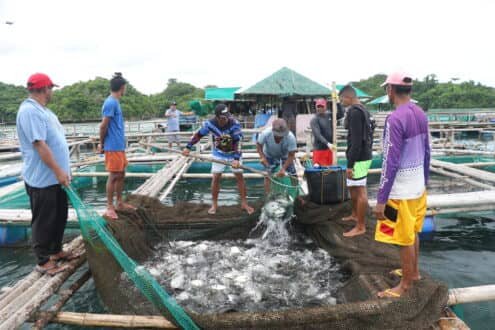by SEAFDEC/AQD
A delectable fish that needs no seasoning, no need for scaling, has few bones, fits perfectly on a pan, and whose mild and sweet flavor suits almost any recipe. It’s no wonder that the pompano is called by some to be the “world’s most edible fish.”

This silvery fish, with a pearly-white meat when cooked, is known as “apahan” or “dawis lawin” in the Philippines. Its market price is between P300 and P500 per kilogram, depending on size, which is usually between 250 to 500 grams.
Pompano naturally inhabit coral reefs, but they also adapt well to being farmed in marine fish cages and brackishwater fishponds where they grow fast and readily take in formulated feeds.
However, despite its proven culinary and aquaculture value worldwide, pompano is yet to take off in the Philippines. This is mainly because of the lack of pompano fingerlings to stock into cages and ponds, and sea lice infections.
Regardless, an international research center based in Tigbauan, Iloilo is bent on promoting the pompano as the next big thing in Philippine aquaculture.
“We have been actively researching the snubnose pompano since 2007, but in the past two years we have intensified our commercialization projects to show the industry that pompano farming is a good investment,” shared Dan Baliao, chief of SEAFDEC/AQD.
Between January and August 2022, Baliao added that they harvested pompano 10 times from both marine cages and brackishwater ponds, netting a total of 14 tons of the high-value commodity through its multiple experimental runs.
The research center is also constructing a dedicated pompano hatchery at its Tigbauan headquarters to further boost its research and commercialization activities. The new facility has a rearing capacity of 80 tons and may also supply private farmers.
Baliao also shared that SEAFDEC/AQD has already published research and continues to do studies on multiple fronts, including the development of a low-cost diet, strategies to accelerate growth in the nursery stage, reducing sea lice infestations, and preventing transmission of nervous necrosis virus that affects pompano breeders and larvae.
Alternative to milkfish?
Because pompano is relatively easy to raise and uses the same pond and cage setup, Baliao said the pompano is a good alternative to milkfish, which is currently the top-farmed fish in the Philippines.
“With its superior taste and premium value, pompano is something fish farmers should seriously consider. The Philippines just needs more investments in pompano hatcheries to provide the seeds that farmers will need.”
To this end, Baliao says SEAFDEC/AQD has been in close partnership with the Department of Agriculture’s Bureau of Fisheries and Aquatic Resources (DA-BFAR) since 2018 in designing and setting up multi-species hatcheries around the country.
“It will just be a matter of time. The technology to produce pompano is there, and SEAFDEC continues to add refinements every year. Help us commercialize our science, and you will soon taste and see that pompano is good.”
Marine and brackish water culture
SEAFDEC/AQD has been raising pompano in marine fish cages since 2008, feeding them formulated feeds. A stocking density of 35 fish per cubic meter is used in the sea cages which are 10 meters wide, 10 meters long, and 4 meters deep.
In fish cage culture, fish can be stocked at higher densities, harvest is easier, and predation is more easily controlled. The constantly flowing water also provides abundant dissolved oxygen and flushes away waste products and unconsumed feeds.
The research center also raises the pompano in 5,000 square meter brackishwater ponds, with the salinity as low as 20 ppt, at a stocking density of 0.5 to two fish per square meter. In pond culture, there are no expenses for nets and mooring, and natural food can grow, reducing the demand for commercial feeds.
Whether in cages or in ponds, it takes four to five months for the fish to reach marketable size.
Editor at the digital magazine AquaHoy. He holds a degree in Aquaculture Biology from the National University of Santa (UNS) and a Master’s degree in Science and Innovation Management from the Polytechnic University of Valencia, with postgraduate diplomas in Business Innovation and Innovation Management. He possesses extensive experience in the aquaculture and fisheries sector, having led the Fisheries Innovation Unit of the National Program for Innovation in Fisheries and Aquaculture (PNIPA). He has served as a senior consultant in technology watch, an innovation project formulator and advisor, and a lecturer at UNS. He is a member of the Peruvian College of Biologists and was recognized by the World Aquaculture Society (WAS) in 2016 for his contribution to aquaculture.
